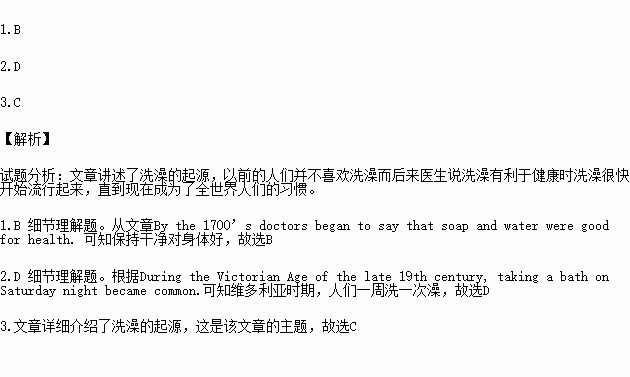题目内容
Baths and bathing have long been considered of medical importance to man. In Greece there are the ruins of a water system for baths built over 3,000 years ago. The Romans had warm public baths. In some baths, as many 3,000 persons could bathe at the same time.
Treating disease by taking bathing has been popular for centuries. Modern medical bathing first became popular in Europe and by the late 1700’s has also become popular in the United States.
For many years frequent bathing was believed to be bad for one’s health. Ordinary bathing just to keep clean was avoided, and perfume was often used to cover up body smells!
By the 1700’s doctors began to say that soap and water were good for health. They believed that it was good for people to be clean. Slowly, people began to bathe more frequently. During the Victorian Age of the late 19th century, taking a bath on Saturday night became common.
In the United States ordinary bathing was slow to become popular. During the 18th and early 19th centuries, many Americans were known as “The Great Unwashed!” In one American city, for example, a person was only allowed to take a bath every thirty days! That was a law!
Frequency of bathing today is partly a matter of habit. People know that bathing for cleanliness is important to health. Doctors know that dirty bodies increase the chance of diseases. As a result, in the United States, people generally bathe often. Some people bathe once a day at least. They consider a daily bath essential to good health.
1.In the 18th century doctors believed that being clean was _______.
A. unimportant B. good for health
C. harmful D. popular
2.During the Victorian Age _______.
A. the Americans ever took a bath every thirty days
B. frequent bathing was avoided
C. people used perfume to cover up body smells after bathing
D. the British people generally took a bath once a week.
3.The passage is mainly about _______.
A. bathing in the USA
B. the good points and bad points of bathing
C. the history of bathing
D. the modern medical bathing

